文章目录
SpringBoot整合Redis
测试连接
添加相关依赖
<?xml version="1.0" encoding="UTF-8"?>
<project xmlns="http://maven.apache.org/POM/4.0.0" xmlns:xsi="http://www.w3.org/2001/XMLSchema-instance"
xsi:schemaLocation="http://maven.apache.org/POM/4.0.0 https://maven.apache.org/xsd/maven-4.0.0.xsd">
<modelVersion>4.0.0</modelVersion>
<parent>
<groupId>org.springframework.boot</groupId>
<artifactId>spring-boot-starter-parent</artifactId>
<version>2.2.6.RELEASE</version>
<relativePath/> <!-- lookup parent from repository -->
</parent>
<groupId>com.sin</groupId>
<artifactId>demo-springboot-redis</artifactId>
<version>0.0.1-SNAPSHOT</version>
<name>demo-springboot-redis</name>
<description>Demo project for Spring Boot</description>
<properties>
<java.version>1.8</java.version>
</properties>
<dependencies>
<dependency>
<groupId>org.springframework.boot</groupId>
<artifactId>spring-boot-starter</artifactId>
</dependency>
<!-- redis -->
<dependency>
<groupId>org.springframework.boot</groupId>
<artifactId>spring-boot-starter-data-redis</artifactId>
</dependency>
<!--
apache通用连接池
提供了对可复用的对象(如数据库连接,线程等)的池化管理,有助于提高资源的利用率和系统的 性能
使用commons-pool2来管理与Redis数据库的连接池
-->
<dependency>
<groupId>org.apache.commons</groupId>
<artifactId>commons-pool2</artifactId>
</dependency>
<!-- mysql -->
<dependency>
<groupId>mysql</groupId>
<artifactId>mysql-connector-java</artifactId>
</dependency>
<!-- mybatis -->
<dependency>
<groupId>org.mybatis.spring.boot</groupId>
<artifactId>mybatis-spring-boot-starter</artifactId>
<version>2.2.2</version>
</dependency>
<!-- 通用mapper -->
<dependency>
<groupId>tk.mybatis</groupId>
<artifactId>mapper-spring-boot-starter</artifactId>
<version>2.1.5</version>
</dependency>
<!-- lombok -->
<dependency>
<groupId>org.projectlombok</groupId>
<artifactId>lombok</artifactId>
</dependency>
<dependency>
<groupId>org.springframework.boot</groupId>
<artifactId>spring-boot-starter-test</artifactId>
<scope>test</scope>
</dependency>
<dependency>
<groupId>junit</groupId>
<artifactId>junit</artifactId>
<scope>test</scope>
</dependency>
<!-- 解析yaml -->
<dependency>
<groupId>org.yaml</groupId>
<artifactId>snakeyaml</artifactId>
<version>1.23</version>
</dependency>
<dependency>
<groupId>org.springframework.boot</groupId>
<artifactId>spring-boot-starter-web</artifactId>
</dependency>
</dependencies>
<build>
<plugins>
<plugin>
<groupId>org.springframework.boot</groupId>
<artifactId>spring-boot-maven-plugin</artifactId>
</plugin>
</plugins>
</build>
</project>
package com.sin;
import org.springframework.boot.SpringApplication;
import org.springframework.boot.autoconfigure.SpringBootApplication;
/**
* @author sin
* @date 2022/11/25
* @apiNote
*/
@SpringBootApplication
public class SpringRedisMySQLRun {
public static void main(String[] args) {
SpringApplication.run(SpringRedisMySQLRun.class,args);
System.out.println("===============启动成功================");
}
}
配置
## 配置端口
server:
port: 80
spring:
## 配置数据库数据源
datasource:
driver-class-name: com.mysql.jdbc.Driver
url: jdbc:mysql://localhost:3306/sindemo
username: root
password: 123456
redis:
# 地址
host: 192.168.11.128
# 端口
port: 6379
# 密码
password: 123456
# 超时时间 5000毫秒
timeout: 5000
jedis:
连接池
pool:
# 连接池最小空闲连接
min-idle: 0
# 连接池的最大空闲连接
max-idle: 8
# 连接池最大阻塞等待时间(使用负数表示没有限制)
max-wait: -1
# 连接池最大连接数(使用负数表示没有限制)
max-active: 8
# mybatis配置
mybatis:
# 获取配置文件的地址
mapper-locations: classpath:/mybatis/mapper/*.xml
# 获取实体类的地址
type-aliases-package: com.sin.pojo
configuration:
# 开启驼峰命名
map-underscore-to-camel-case: true
测试项目
package com.sin.controller;
import org.springframework.web.bind.annotation.RequestMapping;
import org.springframework.web.bind.annotation.RestController;
/**
* @author sin
* @date 2022/11/25
* @apiNote
*/
@RestController
public class TestController {
@RequestMapping("/test")
public String testControler(){
System.out.println("测试成功");
return "测试成功";
}
}
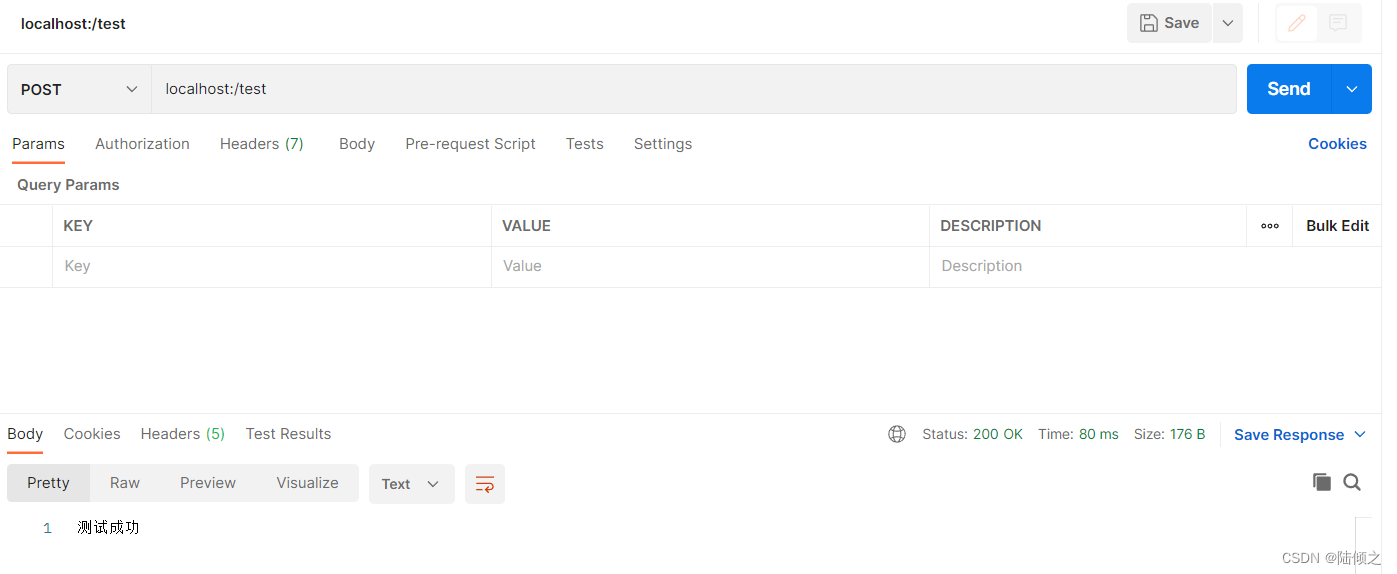
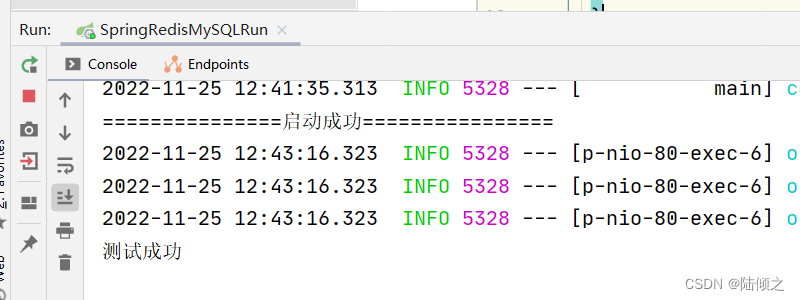
开启Redis服务
## 启动redis
[root@My-Server redis]# cd /usr/local/redis/bin
[root@My-Server bin]# ./redis-server /usr/local/redis/etc/redis.conf
## 进入redis
[root@My-Server bin]# cd /usr/local/redis/bin
[root@My-Server bin]# ./redis-cli
## 密码登录
127.0.0.1:6379> auth 123456
OK
127.0.0.1:6379>
连接Redis测试

RedisTemplate是Spring Data Redis提供的一个强大的Redis操作模板,用于在Spring应用程序中与Redis数据库进行交互。对redis底层开发包(Jedis,JRedis,RJC)进行了一个封装,定义了五种数据结构的操作方法,异常处理,序列化,发布订阅
- opsForValue():操作字符串。
- opsForList():操作列表。
- opsForHash():操作哈希。
- opsForSet():操作集合。
- opsForZSet():操作有序集合。
添加数据
package com.sin.controller;
import org.springframework.beans.factory.annotation.Autowired;
import org.springframework.data.redis.core.RedisTemplate;
import org.springframework.web.bind.annotation.*;
/**
* @author sin
* @date 2022/11/25
* @apiNote
*/
@RestController // 表示该类是一个RESTful风格的控制器,将该类下的所有的方法的返回值直接以JSON或XML的形式写入到HTTP请求体。
public class RedisController {
//注入RedisTemplate
@Autowired
private RedisTemplate redisTemplate;
//添加数据
// @PathVariable 将URL中的key和Value参数映射到方法的参数中
@PostMapping("/addData/key={key}/value={value}")//动态地址
public Object addData(@PathVariable("key") String key,
@PathVariable("value") String value){
redisTemplate.opsForValue().set(key,value);
System.out.println("数据添加成功"+redisTemplate);
return "addData Success"; // 将字符串"addData Success"作为HTTP响应的主体返回给客户端
}
}
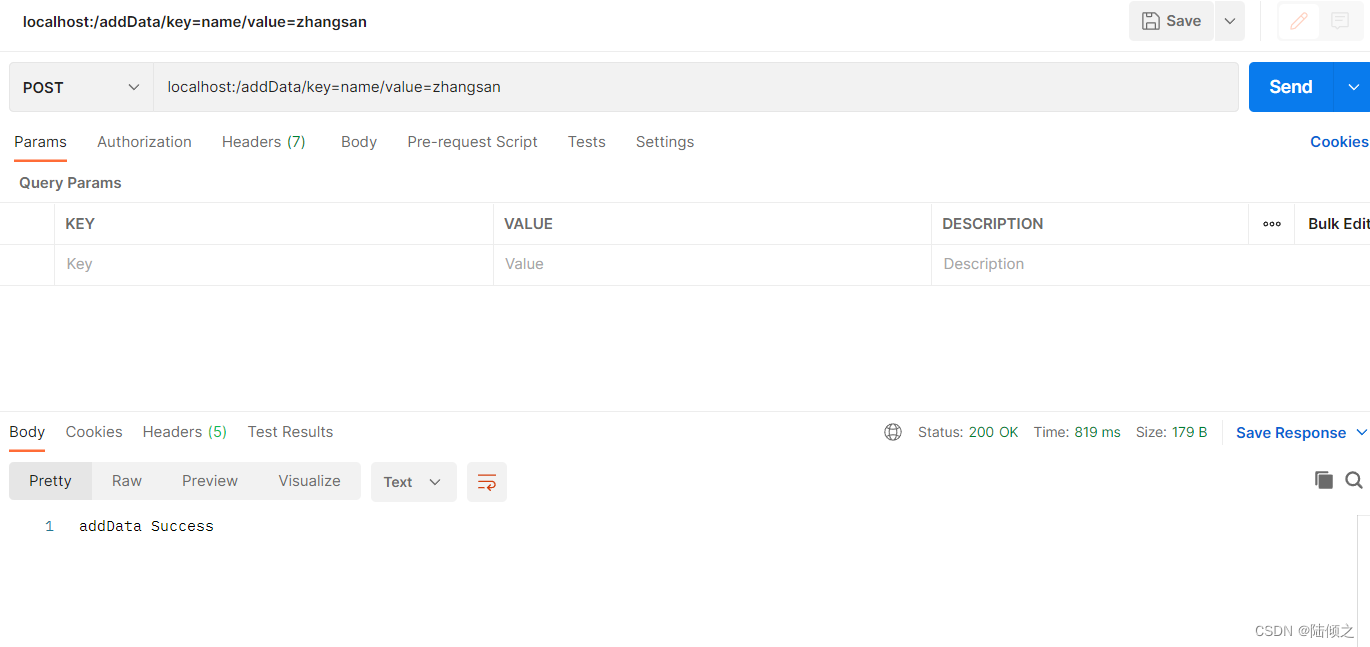
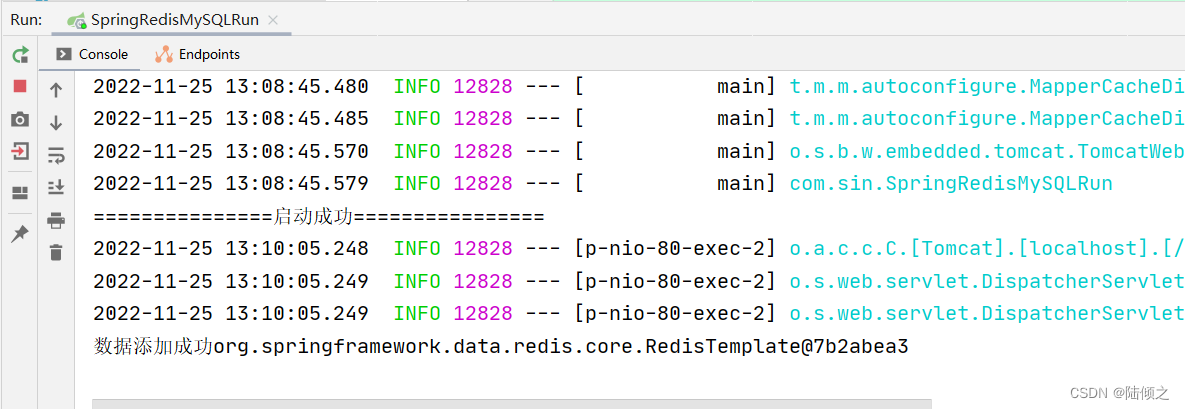
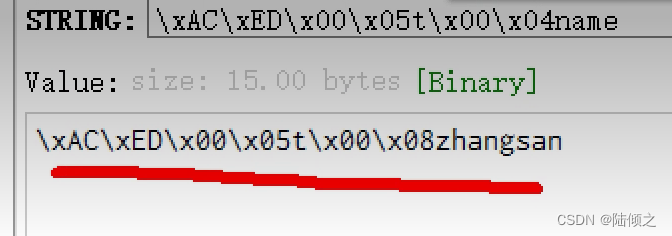
获取数据
//根据key获取value
@GetMapping("/getData/key={key}")
// @PathVariable 将URL中的key和Value参数映射到方法的参数中
public Object getData(@PathVariable("key") String key){
// 根据key获取value
Object value = redisTemplate.opsForValue().get(key);
System.out.println("数据为:"+value);
return value;// 将查询到的数据作为HTTP响应的主体返回给客户端
}

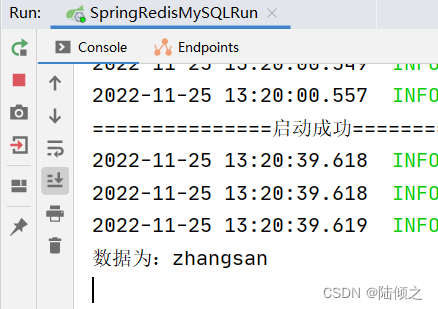
Redis序列化
看到结果后是看不懂的,这个就跟它的序列化有关了。就是根据RedisTemplate将数据写入到redis中的时候会经过一个序列化操作,序列化操作后就变成了以上数据格式,这个并不影响程序,因为set写入时会有序列化操作,get获取数据时也就有着这么一个序列话操作,但是对于我们来说时很不友好的

在源码中我们能看到定义了各种数据类型的序列化的一个成员变量
if (defaultSerializer == null) { //当defaultSerializer为null
// 确保在没有明确指定默认序列化器时,会创建一个JdkSerializationRedisSerializer的实例作为默认的序列化器。
// 默认情况下,它会使用Java对象的标准序列化方式来将对象序列化为字节流,以便存储到Redis中,或者将从Redis中读取的字节流反序列化为Java对象。
defaultSerializer = new JdkSerializationRedisSerializer(
// 如果存在(classLoader)类加载器,就是用classLoader来初始化JdkSerializationRedisSerializer,
// 否则,使用当前类的类加载器(this.getClass().getClassLoader())来初始化。
classLoader != null ? classLoader : this.getClass().getClassLoader());
}
// 通过默认的序列化来处理所有的键和值,以确保序列化和反序列化的一致性
// 如果keySerializer为空
if (keySerializer == null) {
//将keySerializer设置为defaultSerializer
keySerializer = defaultSerializer;
// 并将defaultUsed标记为true。
defaultUsed = true;
}
if (valueSerializer == null) {
valueSerializer = defaultSerializer;
defaultUsed = true;
}
if (hashKeySerializer == null) {
hashKeySerializer = defaultSerializer;
defaultUsed = true;
}
if (hashValueSerializer == null) {
hashValueSerializer = defaultSerializer;
defaultUsed = true;
}
通过这种方式,即使没有明确指定特定的序列化器,也可以保证所有的键和值都会使用相同的序列化器进行处理,从而避免因序列化器不一致而引发的问题。
我们没有定义,它就用的jdk的序列化将数据传输
package com.sin.conf;
import org.springframework.context.annotation.Bean;
import org.springframework.context.annotation.Configuration;
import org.springframework.data.redis.connection.RedisConnectionFactory;
import org.springframework.data.redis.core.RedisTemplate;
import org.springframework.data.redis.serializer.Jackson2JsonRedisSerializer;
/**
* @author sin
* @date 2022/11/25
* @apiNote
*/
@Configuration //表示该类为配置类
public class RedisConfig {
@Bean
public RedisTemplate<String,Object> redisTemplate(RedisConnectionFactory connectionFactory){
//实例化RedisTemplate
RedisTemplate<String,Object> redisTemplate = new RedisTemplate<>();
//设置连接工厂
redisTemplate.setConnectionFactory(connectionFactory);
//指定k,v的序列化方式(json)
Jackson2JsonRedisSerializer jackson2JsonRedisSerializer = new Jackson2JsonRedisSerializer(Object.class);
//默认序列化为json格式
redisTemplate.setDefaultSerializer(jackson2JsonRedisSerializer);
return redisTemplate;
}
}
Json序列化

package com.sin.conf;
import org.springframework.context.annotation.Bean;
import org.springframework.context.annotation.Configuration;
import org.springframework.data.redis.connection.RedisConnectionFactory;
import org.springframework.data.redis.core.RedisTemplate;
import org.springframework.data.redis.serializer.Jackson2JsonRedisSerializer;
import org.springframework.data.redis.serializer.StringRedisSerializer;
/**
* @author sin
* @date 2022/11/25
* @apiNote
*/
@Configuration //表示该类为配置类
public class RedisConfig {
@Bean
public RedisTemplate<String,Object> redisTemplate(RedisConnectionFactory connectionFactory){
//实例化RedisTemplate
RedisTemplate<String,Object> redisTemplate = new RedisTemplate<>();
//设置连接工厂
redisTemplate.setConnectionFactory(connectionFactory);
//指定k,v的序列化方式(json)
Jackson2JsonRedisSerializer jackson2JsonRedisSerializer = new Jackson2JsonRedisSerializer(Object.class);
// //默认序列化为json格式
// redisTemplate.setDefaultSerializer(jackson2JsonRedisSerializer);
//key设置为String类型
redisTemplate.setKeySerializer(new StringRedisSerializer());
//value设置为Json格式
redisTemplate.setValueSerializer(jackson2JsonRedisSerializer);
return redisTemplate;
}
}
key为String格式,value为Json格式
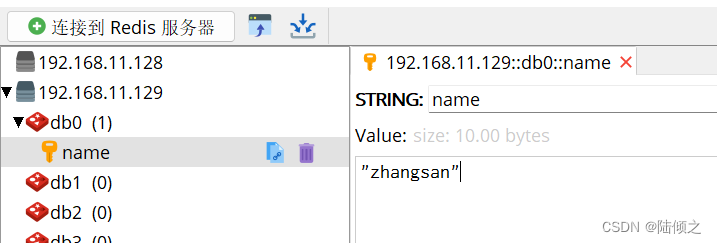
Springboot整合redis使用
RedisConfig
package com.sin.demo.config;
import com.fasterxml.jackson.annotation.JsonAutoDetect;
import com.fasterxml.jackson.annotation.PropertyAccessor;
import com.fasterxml.jackson.databind.ObjectMapper;
import org.springframework.cache.annotation.CachingConfigurerSupport;
import org.springframework.cache.annotation.EnableCaching;
import org.springframework.context.annotation.Bean;
import org.springframework.context.annotation.Configuration;
import org.springframework.data.redis.connection.RedisConnectionFactory;
import org.springframework.data.redis.core.*;
import org.springframework.data.redis.serializer.Jackson2JsonRedisSerializer;
import org.springframework.data.redis.serializer.StringRedisSerializer;
/**
* redis配置类
*
*/
@EnableCaching
@Configuration//标记该类为配置类,
public class RedisConfig {
/**
* 对读写的数据进行序列化操作
* @param factory 连接工厂,
* @return
*/
@Bean
public RedisTemplate<String,Object> redisTemplate(RedisConnectionFactory factory){
//实例化redisTemplate
RedisTemplate<String, Object> redisTemplate = new RedisTemplate<>();
//设置连接工厂
redisTemplate.setConnectionFactory(factory);
Jackson2JsonRedisSerializer<Object> redisSerializer = new Jackson2JsonRedisSerializer<>(Object.class);
//ObjectMapper以json进行读写操作
ObjectMapper mapper = new ObjectMapper();
//指定要序列化的域,field,get和set,以及修饰符范围,ANY是都有包括private和public
mapper.setVisibility(PropertyAccessor.ALL, JsonAutoDetect.Visibility.ANY);
redisSerializer.setObjectMapper(mapper);
//设置默认的序列化
//redisTemplate.setDefaultSerializer(new StringRedisSerializer());
//实际开发中key为字符串序列化,value为json序列化
redisTemplate.setKeySerializer(new StringRedisSerializer());
redisTemplate.setValueSerializer(redisSerializer);
//hash序列化
redisTemplate.setHashKeySerializer(new StringRedisSerializer());
redisTemplate.setHashValueSerializer(redisSerializer);
redisTemplate.afterPropertiesSet();
return redisTemplate;
}
/**
* 对redis操作String数据类型
* @param redisTemplate
* @return
*/
@Bean
public ValueOperations<String,Object> valueOperations(RedisTemplate<String,Object> redisTemplate){
return redisTemplate.opsForValue();
}
/**
* Redis操作List数据类型
* @param redisTemplate
* @return
*/
@Bean
public ListOperations<String,Object> listOperations(RedisTemplate<String,Object> redisTemplate){
return redisTemplate.opsForList();
}
/**
* Redis操作Hash数据类型
* @param redisTemplate
* @return
*/
@Bean
public HashOperations<String,String,Object> hashOperations(RedisTemplate<String,Object> redisTemplate){
return redisTemplate.opsForHash();
}
/**
* Redis操作set数据类型
* @param redisTemplate
* @return
*/
@Bean
public SetOperations<String,Object> setOperations(RedisTemplate<String,Object> redisTemplate){
return redisTemplate.opsForSet();
}
/**
* Redis操作zSet数据类型
* @param redisTemplate
* @return
*/
public ZSetOperations<String,Object> zSetOperations(RedisTemplate<String,Object> redisTemplate){
return redisTemplate.opsForZSet();
}
}
RedisTemplate封装
package com.sin.demo.util;
import org.springframework.beans.factory.annotation.Autowired;
import org.springframework.data.redis.core.RedisTemplate;
import org.springframework.stereotype.Component;
import org.springframework.util.CollectionUtils;
import sun.security.ec.point.ProjectivePoint;
import java.util.Collection;
import java.util.List;
import java.util.Map;
import java.util.Set;
import java.util.concurrent.TimeUnit;
/**
* redisTemplate封装
*/
@Component
public class RedisUtil {
@Autowired
private RedisTemplate<String,Object> redisTemplate;
public RedisUtil(RedisTemplate<String, Object> redisTemplate) {
this.redisTemplate = redisTemplate;
}
/**
* 指定缓存失效时间
* @param key
* @param time
* @return
*/
public boolean expire(String key,long time){
try {
if (time > 0) {
redisTemplate.expire(key, time, TimeUnit.SECONDS);
}
return true;
}catch (Exception e){
e.printStackTrace();
return false;
}
}
/**
* 指定key过期时间
* @param key
* @return
*/
public long getExpire(String key){
return redisTemplate.getExpire(key,TimeUnit.SECONDS);
}
/**
* 判断key是否存在
* @param key
* @return
*/
public boolean hasKey(String key){
try {
return redisTemplate.hasKey(key);
}catch (Exception e){
e.printStackTrace();
return false;
}
}
/**
* 删除缓存
* @param key
*/
@SuppressWarnings("unchecked")
public void del(String ... key){
if(key!=null&&key.length>0){
if(key.length==1){
redisTemplate.delete(key[0]);
}else {
redisTemplate.delete((Collection<String>) CollectionUtils.arrayToList(key));
}
}
}
//=====================================================Redis的String数据类型操作=========================================
/**
* 普通缓存的获取
* @param key
* @return
*/
public Object get(String key){
return key==null?null:redisTemplate.opsForValue().get(key);
}
/**
* 普通缓存的存放
* @param key
* @param value
* @return
*/
public boolean set(String key,Object value){
try{
redisTemplate.opsForValue().set(key,value);
return true;
}catch (Exception e){
e.printStackTrace();
return false;
}
}
/**
* 普通缓存放入并设置时间
* @param key
* @param value
* @param time
* @return
*/
public boolean set(String key,Object value,long time){
try{
if(time>0){
redisTemplate.opsForValue().set(key,value,time,TimeUnit.SECONDS);
}else {
set(key,value);
}
return true;
}catch (Exception e){
e.printStackTrace();
return false;
}
}
/**
* 递增
* @param key
* @param delta
* @return
*/
public long incr(String key,long delta){
if (delta<0){
throw new RuntimeException("递增的条件必须大于0");
}
return redisTemplate.opsForValue().increment(key,delta);
}
/**
* 递减
* @param key
* @param delta
* @return
*/
public long decr(String key,long delta){
if (delta<0){
throw new RuntimeException("递减的条件不许大于0");
}
return redisTemplate.opsForValue().decrement(key,-delta);
}
//===============================================redis的Hash数据类型操作====================================================
/**
* Hashget
* @param key 不能为null
* @param itme 不能为null
* @return
*/
public Object hget(String key,String itme ){
return redisTemplate.opsForHash().get(key,itme);
}
/**
* 获取hashkey对应的所有键值
* @param key
* @return
*/
public Map<Object,Object> hmget(String key){
return redisTemplate.opsForHash().entries(key);
}
/**
* HashSet
*/
public boolean hmset (String key,Map<String,Object> map){
try {
redisTemplate.opsForHash().putAll(key,map);
return true;
}catch (Exception e){
e.printStackTrace();
return false;
}
}
/**
* Hashset 设置时间
* @param key
* @param map
* @param time
* @return
*/
public boolean hmset(String key,Map<String,Object>map,long time){
try{
redisTemplate.opsForHash().putAll(key,map);
if(time>0){
expire(key,time);
}
return true;
}catch (Exception e){
e.printStackTrace();
return false;
}
}
/**
* 向一张hash表中放入数据,如果不存在就将其创建
* @param key
* @param item 项
* @param value
* @return
*/
public boolean hset(String key,String item,String value){
try{
redisTemplate.opsForHash().put(key,item,value);
return true;
}catch (Exception e){
e.printStackTrace();
return false;
}
}
/**
* 向一张hash表中放入数据,如果不存在就将其创建,对时间的操作
* @param key
* @param item
* @param value
* @param time
* @return
*/
public boolean hset(String key,String item,String value,long time){
try{
redisTemplate.opsForHash().put(key,item,value);
if (time>0){
expire(key,time);
}
return true;
}catch (Exception e){
e.printStackTrace();
return false;
}
}
/**
* 删除hash表中的值
* @param key
* @param item
*/
public void hdel(String key,Object ... item){
redisTemplate.opsForHash().delete(key,item);
}
/**
* 判断Hash表中是否有该项的值
* @param key
* @param item
* @return
*/
public boolean hHasKey(String key,String item){
return redisTemplate.opsForHash().hasKey(key,item);
}
/**
* hash递增,如果不存在,就会创建一个,并把新增后的值返回
* @param key
* @param item
* @param by 要增加几(大于0)
* @return
*/
public double hincr(String key,String item,double by){
return redisTemplate.opsForHash().increment(key,item,by);
}
/**
* 递减操作
* @param key
* @param item
* @param by 要减少几(小于0)
* @return
*/
public double hdecr(String key,String item,double by){
return redisTemplate.opsForHash().increment(key,item,by);
}
//===============================================redis的set数据类型操作====================================================
/**
* 根据key获取set中的所有值
* @param key
* @return
*/
public Set<Object> sGet(String key){
try {
return redisTemplate.opsForSet().members(key);
}catch (Exception e){
e.printStackTrace();
return null;
}
}
/**
* 根据value从一个set中查询,是否存在
* @param key
* @param value
* @return
*/
public boolean sHasKey(String key,Object value){
try {
return redisTemplate.opsForSet().isMember(key,value);
}catch (Exception e){
e.printStackTrace();
return false;
}
}
/**
* 将数据放入set缓存中
* @param key
* @param values
* @return 成功个数
*/
public long sSet(String key,Object ... values){
try{
return redisTemplate.opsForSet().add(key,values);
}catch (Exception e){
e.printStackTrace();
return 0;
}
}
/**
* 将set数据放入缓存
* @param key
* @param time
* @param values
* @return 成功个数
*/
public long sSetAndTime(String key,long time,Object ... values){
try{
Long count = redisTemplate.opsForSet().add(key, values);
if(time>0){
expire(key,time);
}
return count;
}catch (Exception e){
e.printStackTrace();
return 0;
}
}
/**
* 获取set缓存的长度
* @param key
* @return
*/
public long sGetSetSize(String key){
try {
return redisTemplate.opsForSet().size(key);
}catch (Exception e){
e.printStackTrace();
return 0;
}
}
/**
* 移除值为value的
* @param key
* @param values
* @return
*/
public long setRemove(String key,Object ... values){
try {
Long count = redisTemplate.opsForSet().remove(key, values);
return count;
}catch (Exception e){
e.printStackTrace();
return 0;
}
}
//===============================================redis的list数据类型操作====================================================
/**
* 获取list缓存的内容
* @param key
* @param start 开始
* @param end 结束(0到-1表示所有值)
* @return
*/
public List<Object> lGet(String key,long start,long end){
try {
return redisTemplate.opsForList().range(key,start,end);
}catch (Exception e){
e.printStackTrace();
return null;
}
}
/**
* 获取list缓存的长度
* @param key
* @return
*/
public long lGetListSize(String key){
try {
return redisTemplate.opsForList().size(key);
}catch (Exception e){
e.printStackTrace();
return 0;
}
}
/**
* 通过索引,获取list中的值
* @param key
* @param index 索引,index>=0时,0表示开头,1表示第二个元素;index《=0时,-1表示末尾,-2表示第二个元素,
* @return
*/
public Object lGetIndex(String key,long index){
try{
return redisTemplate.opsForList().index(key,index);
}catch (Exception e ){
e.printStackTrace();
return null;
}
}
/**
* 将list放入缓存
* @param key
* @param value
* @return
*/
public boolean lSet(String key,Object value){
try {
redisTemplate.opsForList().rightPush(key,value);
return true;
}catch (Exception e){
e.printStackTrace();
return false;
}
}
/**
* 将list放入缓存中,对时间操作
* @param key
* @param value
* @param time
* @return
*/
public boolean lSet(String key,Object value,long time){
try {
redisTemplate.opsForList().rightPush(key,value);
if (time>0){
expire(key,time);
}
return true;
}catch (Exception e){
e.printStackTrace();
return false;
}
}
/**
* 将list放入缓存
* @param key
* @param values
* @return
*/
public boolean lSetList(String key,List<Object> values){
try {
redisTemplate.opsForList().rightPushAll(key,values);
return true;
}catch (Exception e){
e.printStackTrace();
return false;
}
}
/**
* 将list放入缓存中,对时间操作
* @param key
* @param values
* @param time
* @return
*/
public boolean lSetList(String key,List<Object> values ,long time){
try {
redisTemplate.opsForList().rightPushAll(key,values);
if(time>=0){
expire(key,time);
}
return true;
}catch (Exception e){
e.printStackTrace();
return false;
}
}
/**
* 根据索引修改list中的数据
* @param key
* @param index
* @param value
* @return
*/
public boolean lUpdateIndex(String key,long index,Object value){
try {
redisTemplate.opsForList().set(key,index,value);
return true;
}catch (Exception e){
e.printStackTrace();
return false;
}
}
/**
* 移除n个值
* @param key
* @param count
* @param value
* @return
*/
public long lRemove(String key,long count,Object value){
try{
return redisTemplate.opsForList().remove(key,count,value);
}catch (Exception e){
e.printStackTrace();
return 0;
}
}
}
编写实体类
public class Student {
private Integer id;
private String name ;
private Integer age;
private String dept;//班级
set,get方法
}
RedisController类
package com.sin.controller;
import com.sin.pojo.Student;
import com.sin.util.RedisUtil;
import org.springframework.beans.factory.annotation.Autowired;
import org.springframework.data.redis.core.RedisTemplate;
import org.springframework.web.bind.annotation.*;
import javax.annotation.Resource;
import java.util.ArrayList;
import java.util.List;
/**
* @author sin
* @date 2022/11/25
* @apiNote
*/
@RestController
public class RedisController {
//注入RedisTemplate
@Autowired
private RedisTemplate redisTemplate;
@Autowired
private RedisUtil redisUtil;
//添加数据
@PostMapping("/addData/key={key}/value={value}")//动态地址
public Object addData(@PathVariable("key") String key,
@PathVariable("value") String value){
redisTemplate.opsForValue().set(key,value);
System.out.println("数据添加成功"+redisTemplate);
return "addData Success";
}
//根据key获取value
@GetMapping("/getData/key={key}")
public Object getData(@PathVariable("key") String key){
Object value = redisTemplate.opsForValue().get(key);
System.out.println("数据为:"+value);
return redisTemplate.opsForValue().get(key);
}
/**
* 添加list对象数据到redis中
* @return
*/
@RequestMapping(value = "/setList")
public boolean setList(){
List<Object> stuList = new ArrayList<>();
Student student = new Student();
student.setId(1);
student.setAge(23);
student.setDept("saas");
student.setName("张三");
Student student1 = new Student();
student1.setId(2);
student1.setAge(22);
student1.setDept("微服务");
student1.setName("李四");
Student student2 = new Student();
student2.setId(3);
student2.setAge(23);
student2.setDept("saas");
student2.setName("王五");
Student student3 = new Student();
student3.setId(4);
student3.setAge(24);
student3.setDept("微服务");
student3.setName("赵六");
stuList.add(student);
stuList.add(student1);
stuList.add(student2);
stuList.add(student3);
return redisUtil.lSetList("student",stuList);
}
/**
* 获取全部数据
* @return
*/
@RequestMapping(value = "getList")
public Object getList(){
return redisUtil.lGet("student",0,-1);
}
}


SpringBoot整合Redis+Mybatis
SpringBoot+SpringMVC+redis+mysql来实现项目中的crud操作,redis做缓存数据库,针对频繁需要查询或者解决单点问题都会把数据库到redis来分配服务器压力。
实体类
create table demo_user(
id int(10) auto_increment primary key not null ,
user_name varchar(40) not null ,
password varchar(10) not null ,
sex int(10) not null );
alter table demo_user charset = utf8;
alter table demo_user convert to character set utf8;
public class DemoUser implements Serializable {
private long id;
private String userName;
private String password;
private long sex;
// setter getter方法
}
dao层
package com.sin.mapper;
import com.sin.pojo.DemoUser;
import org.apache.ibatis.annotations.*;
import org.springframework.stereotype.Repository;
import java.util.List;
/**
* dao层
*/
@Repository
@Mapper
public interface DemoUserMapper {
//用户列表
@Select("select * from demo_user")
@Results({
@Result(property = "userName",column = "user_name"),
@Result(property = "password",column = "password")
})
List<DemoUser> queryAll();
//根据id获取demo_user
@Select("select * from demo_user where id = #{id}")
@Results({
@Result(property = "userName",column = "user_name"),
@Result(property = "password",column = "password")
})
DemoUser findUserById(int id);
@Options(useGeneratedKeys = true,keyProperty = "id",keyColumn = "id")
@Insert("insert into demo_user(id,user_name,password,sex)values" +
"(#{id},#{userName},#{password},#{sex})")
int add(DemoUser user);
@Select("select * from demo_user where user_name = #{userName} ")
@Results({
@Result(property = "userName",column = "user_name"),
@Result(property = "password",column = "password")
})
DemoUser findUserByName(String userName);
//根据id修改demoUser
@Update("update demo_user set user_name=#{userName},password=#{password}," +
"sex=#{sex} where id=#{id}")
int updateUser(DemoUser demoUser);
//删除用户
@Delete("delete from demo_user where id = #{id}")
int deleteUserById(int id);
}
config
package com.sin.config;
import com.fasterxml.jackson.annotation.JsonAutoDetect;
import com.fasterxml.jackson.annotation.PropertyAccessor;
import com.fasterxml.jackson.databind.ObjectMapper;
import org.springframework.boot.autoconfigure.cache.CacheProperties;
import org.springframework.cache.CacheManager;
import org.springframework.cache.annotation.CachingConfigurerSupport;
import org.springframework.context.annotation.Bean;
import org.springframework.data.redis.cache.RedisCacheConfiguration;
import org.springframework.data.redis.cache.RedisCacheManager;
import org.springframework.data.redis.cache.RedisCacheWriter;
import org.springframework.data.redis.connection.RedisConnectionFactory;
import org.springframework.data.redis.connection.RedisInvalidSubscriptionException;
import org.springframework.data.redis.core.*;
import org.springframework.data.redis.serializer.Jackson2JsonRedisSerializer;
import org.springframework.data.redis.serializer.StringRedisSerializer;
import java.time.Duration;
/**
* redis 配置类
* 配置redisTemplate序列化
*/
public class RedisConfig extends CachingConfigurerSupport {
/**
* 选择redis作为默认缓存工具
*
*/
@Bean
public CacheManager cacheManager(RedisConnectionFactory redisConnectionFactory){
//设置缓存时间为一个小时
RedisCacheConfiguration redisCacheConfiguration = RedisCacheConfiguration.defaultCacheConfig()
.entryTtl(Duration.ofHours(1));
return RedisCacheManager.builder(RedisCacheWriter.lockingRedisCacheWriter(redisConnectionFactory))
.cacheDefaults(redisCacheConfiguration).build();
}
/**
* 配置redisTemplate相关配置
*
*/
@Bean
public RedisTemplate<String,Object> redisTemplate(RedisConnectionFactory factory){
RedisTemplate<String,Object> redisTemplate = new RedisTemplate<>();
//配置连接工厂
redisTemplate.setConnectionFactory(factory);
//使用Jackson2JsonRedisSerializer来序列化何反序列化redis的value值
Jackson2JsonRedisSerializer jsonRedisSerializer = new Jackson2JsonRedisSerializer(Object.class);
ObjectMapper objectMapper = new ObjectMapper();
//指定要序列化的域,field,get和set,以及修饰符范围,ANY都是有private和public
objectMapper.setVisibility(PropertyAccessor.ALL, JsonAutoDetect.Visibility.ANY);
//指定序列化输入的类型,类必须时非final修饰的,
objectMapper.enableDefaultTyping(ObjectMapper.DefaultTyping.NON_FINAL);
jsonRedisSerializer.setObjectMapper(objectMapper);
//值采用json序列化
redisTemplate.setValueSerializer(jsonRedisSerializer);
//使用StringRedisSerrializer来序列化和反序列化redis的key值
redisTemplate.setKeySerializer(new StringRedisSerializer());
//设置hash key 和value序列化模式
redisTemplate.setHashKeySerializer(new StringRedisSerializer());
redisTemplate.setHashValueSerializer(jsonRedisSerializer);
redisTemplate.afterPropertiesSet();
return redisTemplate;
}
/*
* 对hash类型的数据操作
*/
@Bean
public HashOperations<String,String,Object> hashOperations(RedisTemplate<String,Object> redisTemplate){
return redisTemplate.opsForHash();
}
/**
* 对redis 字符串String类型数据操作
*/
@Bean
public ValueOperations<String,Object> valueOperations(RedisTemplate<String,Object> redisTemplate){
return redisTemplate.opsForValue();
}
/**
* 对redis 链表list类型数据操作
*/
@Bean
public ListOperations<String,Object>listOperations(RedisTemplate<String,Object> redisTemplate){
return redisTemplate.opsForList();
}
/**
* 对redis 无序集合set类型数据操作
*/
@Bean
public SetOperations<String,Object> setOperations(RedisTemplate<String,Object> redisTemplate){
return redisTemplate.opsForSet();
}
/**
* 对redis 有序结合zset类型数据操作
*/
@Bean
public ZSetOperations<String,Object> zSetOperations(RedisTemplate<String,Object> redisTemplate){
return redisTemplate.opsForZSet();
}
}
service
public interface DemoUserService {
//查询全部
List<DemoUser> queryAll();
//根据id查询
DemoUser findUserById(int id);
//根据id进行修改
int updateUser(DemoUser demoUser);
//根据id进行删除
int deleteUserById(int id);
//添加数据
int addUser(DemoUser user);
}
impl
package com.sin.service.impl;
import com.sin.mapper.DemoUserMapper;
import com.sin.pojo.DemoUser;
import com.sin.service.DemoUserService;
import org.springframework.beans.factory.annotation.Autowired;
import org.springframework.data.redis.core.RedisTemplate;
import org.springframework.data.redis.core.ValueOperations;
import org.springframework.stereotype.Service;
import java.util.List;
import java.util.concurrent.TimeUnit;
@Service
public class DemoUserServiceImpl implements DemoUserService {
@Autowired
private DemoUserMapper demoUserMapper;
@Autowired
private RedisTemplate redisTemplate;
//查询全部操作
@Override
public List<DemoUser> queryAll() {
return demoUserMapper.queryAll();
}
/**
* 根据id进行查询
* 获取用户策略,先从缓存中获取用户,没有则读取mysql数据,再将读取的数据写入缓存中
*/
@Override
public DemoUser findUserById(int id) {
String key = "user_" + id;
ValueOperations<String,DemoUser> operations = redisTemplate.opsForValue();
//判断redis中是否有键为key的缓存
boolean haskey = redisTemplate.hasKey(key);
if (haskey){
DemoUser user = operations.get(key);
System.out.println("从缓存中获取的数据:"+user.getUserName());
System.out.println("----------------------------------");
return user;
}else {
DemoUser user = demoUserMapper.findUserById(id);
System.out.println("查询数据库中的数据"+ user.getUserName());
System.out.println("--------------------写入数据------------------");
//写入数据
operations.set(key,user,5, TimeUnit.HOURS);
return user;
}
}
/**
* 更新用户
* 先更新数据库,成功之后,删除原来的缓存,再更新缓存
* @param demoUser
* @return
*/
@Override
public int updateUser(DemoUser demoUser) {
ValueOperations<String,DemoUser> operations = redisTemplate.opsForValue();
int result = demoUserMapper.updateUser(demoUser);
if (result!=0){
String key = "user_"+demoUser.getId();
boolean haskey = redisTemplate.hasKey(key);
if (haskey){
redisTemplate.delete(key);
System.out.println("删除缓存中的key----"+key);
}
//将更新后的数据加入缓存中
DemoUser demoUserNew = demoUserMapper.findUserById((int) demoUser.getId());
if (demoUserNew != null){
operations.set(key,demoUserNew,3,TimeUnit.HOURS);
}
}
return result;
}
/**
* 根据id删除
* 删除数据表中的数据,然后删除缓存
* @param id
* @return
*/
@Override
public int deleteUserById(int id) {
int result = demoUserMapper.deleteUserById(id);
String key = "user_" + id;
if (result != 0){
boolean haskey = redisTemplate.hasKey(key);
if (haskey){
redisTemplate.delete(key);
System.out.println("删除了缓存中的key"+ key);
}
}
return result;
}
@Override
public int addUser(DemoUser user) {
DemoUser user1 = demoUserMapper.findUserByName(user.getUserName());
int result;
if (user1 != null){
result = 0;
return result;
}else{
ValueOperations<String,Object> operations = redisTemplate.opsForValue();
result = demoUserMapper.add(user);
if (result != 0 ){
String key = "user_" +user.getId();
boolean haskey = redisTemplate.hasKey(key);
if(haskey){
redisTemplate.delete(key);
}
if (user != null){
operations.set(key,user,3,TimeUnit.HOURS);
}
}
return result;
}
}
}
controller
package com.sin.controller;
import com.sin.pojo.DemoUser;
import com.sin.service.DemoUserService;
import org.apache.catalina.User;
import org.springframework.beans.factory.annotation.Autowired;
import org.springframework.web.bind.annotation.RequestMapping;
import org.springframework.web.bind.annotation.RequestParam;
import org.springframework.web.bind.annotation.RestController;
import java.sql.Timestamp;
import java.util.Date;
import java.util.HashMap;
import java.util.List;
import java.util.Map;
@RestController
public class DemoUserController {
@Autowired
private DemoUserService demoUserService;
@RequestMapping("/queryAll")
public List<DemoUser> queryAll(){
List<DemoUser> list = demoUserService.queryAll();
return list;
}
@RequestMapping("/addUser")
public String addUser(){
DemoUser user = new DemoUser();
user.setUserName("李四");
user.setPassword("12112");
user.setSex(1);
user.setBirthday( new Date());
int resutl= demoUserService.addUser(user);
if (resutl != 0){
return "add DemoUser success";
}
return "add demouser fail";
}
@RequestMapping("/findUserById")
public Map<String,Object> findUserById(@RequestParam int id){
DemoUser user = demoUserService.findUserById(id);
Map<String,Object> result = new HashMap<>();
result.put("id",user.getId());
result.put("username",user.getUserName());
result.put("pwd",user.getPassword());
result.put("sex",user.getSex());
result.put("birthday",user.getBirthday());
return result;
}
@RequestMapping("/updateUser")
public String updateUser(){
DemoUser user = new DemoUser();
user.setId(1);
user.setUserName("张三");
user.setPassword("123456");
user.setSex(18);
user.setBirthday((Timestamp) new Date());
int result = demoUserService.updateUser(user);
if (result != 0){
return "update user success";
}
return "fall";
}
@RequestMapping("/deleteUserById")
public String deleteUserById(@RequestParam int id){
int result = demoUserService.deleteUserById(id);
if (result != 0){
return "delete Success";
}
return "delete fall";
}
}

加入QQ技术交流群(432972658)


























 487
487

 被折叠的 条评论
为什么被折叠?
被折叠的 条评论
为什么被折叠?










